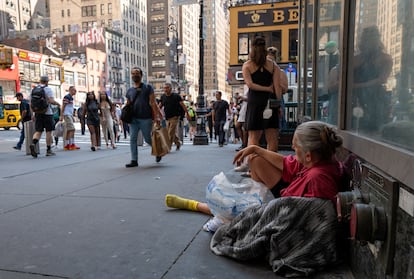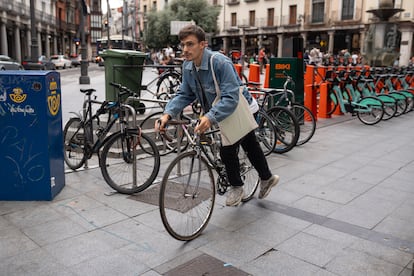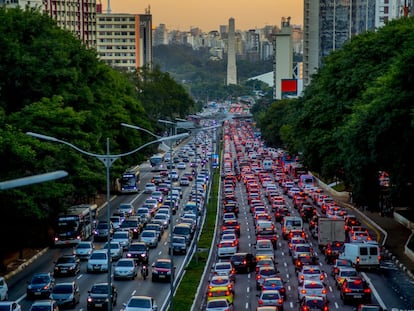Conflict in the contemporary city: Between discomfort, exclusion and pursuit of happiness
In an increasingly urbanized world, cities conceived as products lead to injustice, inequality, touristification, segregation and gentrification. Several books address these problems


The city is not what it used to be. Throughout history, the city has served as a place for survival and coexistence in the company of other people we don’t know. It has been a space for establishing institutions and collective identities. In the beginning, cities also spurred different innovations: since the founding of the first urban centers, there has been a flood of inventions such as the wheel, the coin, the alphabet, money, navigation, etc., as Steven Johnson shows in his book Where Good Ideas Come From: The Natural History of Innovation. Of course, cities also function as a node for business, domination and power. But in recent decades, the neoliberal city has undergone a profound change and become a hostile territory for its inhabitants and a place from which everyone (on a global scale) wants to make a profit. That has led to problems of gentrification, touristification, segregation, inequality, housing insecurity and misery. As Zygmunt Bauman put it, cities have become the “dumping grounds of globalization.”
There’s been a proliferation of books that try to understand these phenomena and seek alternatives to them: according to the United Nations, by the middle of the 21st century, 80% of humans will live in cities, so there are many potentially interested urbanites. “There is particular interest in the urban question, and the presence of housing in debates is noticeable,” says Jorge Dioni López, author of the essay El malestar en las ciudades [Unrest in Cities]. In his view, the city — the place where our existence develops — has become a primary economic product, which causes conflict. “There is a struggle for space between residents and what we might call the ‘movement industry,’ as well as between various types of residents, such as owners and non-owners. In a way, struggles over land ownership have moved from the rural to the urban environment,” the author says.
That includes conflicts related to tourism, the phenomenon of gentrification in which the wealthy classes, investment funds or businesses take control of urban centers, and the problems of managing pockets of poverty and homelessness, whose encampments and lost people now form part of the folklore of large cities. The neoliberal global city, under the glittering patina of modernity, hides inequality and misery. The processes by which the places where we live become global financial assets, designed for speculation and not for living, are studied in In Defense of Housing: The Politics of Crisis, by David Madden and Peter Marcuse (he is philosopher Herbert Marcuse’s son, by the way).

A global city is emerging, which, as sociologist Saskia Sassen defined it in her book The Global City, is a planetary node that seeks to attract flows: flows of capital, information and people, all of which are the means for building a city-narrative and competing in the international market of global cities. That is where world events are decided, and the headquarters of the major multinationals and financial and political forums are located. Consequently, cities all over the planet always aspire to that global status and constantly look outward, in a sort of eternal posturing and desire to seduce, offering business, tourism, culture and nightlife for outsiders. But in so doing, these cities forget about the needs of their inhabitants, especially their need to live.
That state of affairs is a far cry from the “right to the city” Henri Lefebvre discussed in his 1968 essay of the same name. The “right to the city” means that citizens have the right to actively participate in the configuration of the urban spaces they inhabit. Citizens are also entitled to be involved in the friendly and human-scale vision that activist Jane Jacobs proposed in 1961 in her The Death and Life of Great American Cities; the book was inspired by her struggles in the neighborhoods of New York against the grandiloquent ideas of civil servant Robert Moses, a proponent of large highways in pursuit of destroying the neighborhood fabric.
But the city is something else; it is the place where these rights languish. “The most aggressive process is segregation,” says Lopez, that is, the spatial separation between rich and poor, which is one of the reasons for the frequent riots in the Parisian banlieues, including the recent ones. For the author, the city’s commodification implies that its main function is to create value. It must “valorize, monetize, privatize and create different offers for different demands,” as if different spaces — whether residential, work, training or leisure — were offered at a market for different incomes, the haves and the have-nots. Curiously, inequality and segregation are intentional consequences: “It’s not a mistake; it’s the model,” as López reiterates in his book like a revealing mantra. Injustice in the city is not because of ineptitude or lack of foresight; it is precisely what is foreseen by the dominant economic dogma.
The exclusionary city lacks a future
At least since the emergence of modernity, the city has been a place that attracts the masses (the ones who so fascinated poet Charles Baudelaire’s flâneur), whom it includes and offers anonymity. Bauman argues that the public space is precisely that which does not select who inhabits it and allows people who do not know each other to live together. Everyone is welcome. Fabio Ciamarelli, the author of The City of the Excluded (Trotta), observes that for the first time in history, today’s city is one that expels, although the flow of people it attracts continues. In other words, large crowds still want to go to the cities... but the cities are no longer willing to accept them into their midst. That is where conflict arises.

“The object of urban exclusion is first and foremost poverty, inequality. And not just for economic reasons, because the main victim of such exclusion is transformative initiative. Exclusionary cities seem condemned to the standardization of identity, tending toward authoritarianism,” says Ciamarelli. Efficiency and innovation are lost. And the people who are expelled are the ones who are not useful for obtaining maximum profitability (of the new arrivals to the city, tourists are chosen instead of migrants). Public space itself is also excluded, increasingly degraded and privatized; moreover, the future itself is excluded, becoming “simply unthinkable in its novelty and unpredictability. The global city is imprisoned in the present and therefore reluctant to grasp the opportunities represented by the future, which it often only perceives as a threat,” Ciamarelli argues.
In search of the happy city
There are also more hopeful visions of the city, as Charles Montgomery shows in Happy City: Transforming Our Lives Through Urban Design. The author defines a happy city as one that “maximizes health, positive relationships and social inclusion.” Montgomery believes that a city’s main function is to bring people together. These successful cities “draw diverse communities to moments of cooperation, collaboration and common joy,” he adds.

His analysis focuses on solving the housing crisis, which he likens to a public health problem that governments must address with more social housing and by fighting against the epidemic of tourist rental apartments promoted by platforms like AirBnB; that fight would allow workers and students to inhabit urban centers. That also impacts new forms of mobility, beyond the dominance of the car, to improve public spaces: “Although half of daily commuting in Spain is done on foot or by bicycle, most of the road space is dedicated to the private car,” he explains. “Cities would be healthier, happier and more inclusive if more space were devoted to cyclists, pedestrians and public transport.”
He gives the following examples: the commitment to safe spaces for cyclists in Paris, the replacement of highways with public bus routes in Mexico City, and initiatives for easy access to housing around citizen-designed parks in Vienna. “I’m an optimist,” Montgomery says. His book explores alternatives for finding models of coexistence in which new relationships and new ideas flow. “That is the great promise of our cities,” Montgomery argues.
Sign up for our weekly newsletter to get more English-language news coverage from EL PAÍS USA Edition
Tu suscripción se está usando en otro dispositivo
¿Quieres añadir otro usuario a tu suscripción?
Si continúas leyendo en este dispositivo, no se podrá leer en el otro.
FlechaTu suscripción se está usando en otro dispositivo y solo puedes acceder a EL PAÍS desde un dispositivo a la vez.
Si quieres compartir tu cuenta, cambia tu suscripción a la modalidad Premium, así podrás añadir otro usuario. Cada uno accederá con su propia cuenta de email, lo que os permitirá personalizar vuestra experiencia en EL PAÍS.
¿Tienes una suscripción de empresa? Accede aquí para contratar más cuentas.
En el caso de no saber quién está usando tu cuenta, te recomendamos cambiar tu contraseña aquí.
Si decides continuar compartiendo tu cuenta, este mensaje se mostrará en tu dispositivo y en el de la otra persona que está usando tu cuenta de forma indefinida, afectando a tu experiencia de lectura. Puedes consultar aquí los términos y condiciones de la suscripción digital.
More information

Urbicide, or the liturgical murder of the city
Últimas noticias
There is as much life left to discover on planet Earth as that which is already known
Dozens presumed dead, around 100 injured in fire at Swiss Alps bar during New Year’s celebration
Is porn for women different from conventional porn? We spoke to those who make it
Cartagena de Indias is sinking: What can the city do to mitigate it?
Most viewed
- Sinaloa Cartel war is taking its toll on Los Chapitos
- Reinhard Genzel, Nobel laureate in physics: ‘One-minute videos will never give you the truth’
- Oona Chaplin: ‘I told James Cameron that I was living in a treehouse and starting a permaculture project with a friend’
- David King, chemist: ‘There are scientists studying how to cool the planet; nobody should stop these experiments from happening’
- Why the price of coffee has skyrocketed: from Brazilian plantations to specialty coffee houses









































